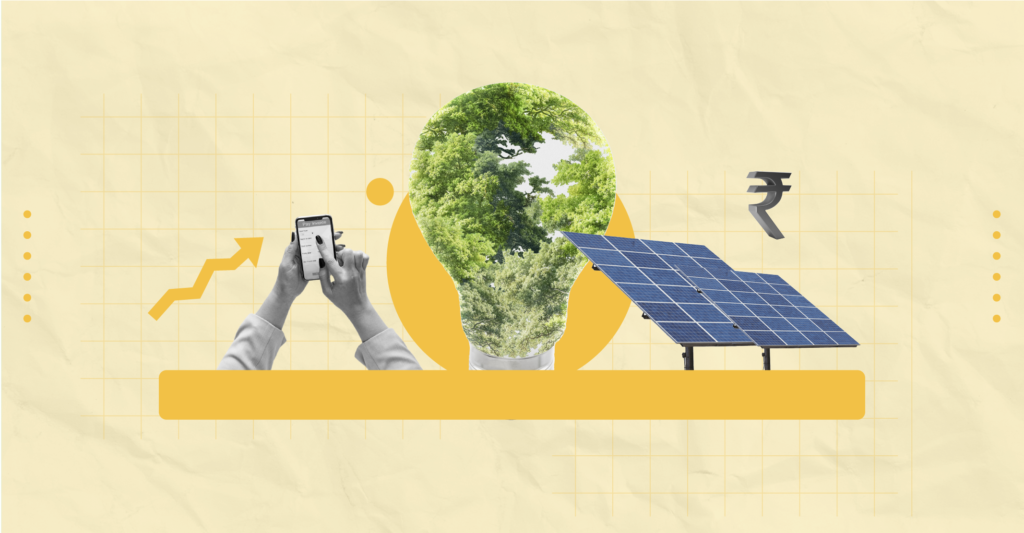Last Updated on Nov 8, 2024 by Vanessa Sequeira
‘Green energy’ is a term we have all heard about lately. It has become a newfound interest in the market. While the world is showing interest in sustainable solutions, several companies also support the cause and work towards green energy. This provides opportunities for investors to invest in green energy. In this article, let’s look into green energy mutual funds in India and the factors to consider before investing in them.
Table of Contents
What Are Green Energy Mutual Funds?
As the name suggests, green energy mutual funds invest in companies operating in the green energy and resources sector, i.e., the companies that generate energy from sources such as wind, solar, hydro, etc. Such funds align with sustainability efforts and appeal to environmentally conscious investors looking for opportunities in renewable energy mutual funds.
List of Green Energy Mutual Funds in India
Here are a few green energy mutual funds in India for potential investors.
| Name | AUM (Rs. in cr.) | CAGR 3Y (%) | Expense Ratio (%) | Tracking Error (%) | Volatility (%) |
| SBI Energy Opportunities Fund | 11,717.96 | 0.00 | 0.57 | 7.53 | 21.33 |
| ICICI Pru Energy Opportunities Fund | 10,493.64 | 0.00 | 0.43 | 10.99 | 9.69 |
| Nippon India Power & Infra Fund | 7,863.43 | 32.23 | 0.95 | 6.65 | 19.03 |
| DSP Natural Res & New Energy Fund | 1,335.59 | 19.81 | 0.97 | 0.00 | 20.55 |
| Tata Resources & Energy Fund | 1,062.56 | 16.80 | 0.57 | 4.88 | 20.66 |
Note: The data mentioned here is from Tickertape Mutual Fund Screener and dated as of 4th November 2024. The parameters used to derive the data are as follows:
- Category: Equity
- Sub-category: Sectoral Fund – Energy & Power
- Market Cap: Sorted from high to low
(Considered only the funds that invest in the green energy sector)
🚀 Pro Tip: Use Tickertape’s Mutual Fund Screener to filter and compare funds based on performance, expense ratio, and risk. Find funds that match your goals and risk tolerance for smarter investment choices.
Details of the Green Energy Mutual Funds
SBI Energy Opportunities Fund
The SBI Energy Opportunities Fund is a sectoral fund focused on energy and power and is a significant renewable energy mutual fund in India. The fund is designed to capitalise on the growth opportunities within the energy sector by investing in equities related to energy production, distribution, and infrastructure. This fund follows a growth plan, appealing to investors looking for sector-specific investments.
As of 4 November 2024, the fund holds an Assets Under Management (AUM) of Rs. 11,717.96 cr. The expense ratio is 0.57%. It has a tracking error of 7.53% and a volatility level of 21.33%. The exit load is 1.00%, and the minimum Systematic Investment Plan (SIP) amount is Rs. 500.00.
ICICI Prudential Energy Opportunities Fund
The ICICI Prudential Energy Opportunities Fund targets investment opportunities in the energy and power sector, seeking long-term capital appreciation. The fund implements a growth-focused strategy that appeals to investors interested in energy-related assets. This fund implements a growth-focused strategy that appeals to investors interested in green energy mutual funds in 2024.
As of 4 November 2024, the fund has an AUM of Rs. 10,493.64 cr. and a 3-year CAGR of 0.00%. The expense ratio is 0.43%, with a tracking error of 10.99% and a volatility measure of 9.69%. The exit load is 1.00%.
Nippon India Power & Infrastructure Fund
The Nippon India Power & Infrastructure Fund focuses on long-term wealth creation by investing in power and infrastructure companies. This sectoral fund seeks to leverage growth in power production, distribution, and related infrastructure, making it relevant to those considering renewable energy mutual funds in India.
As of 4 November 2024, the fund’s AUM is Rs. 7,863.43 cr., with a 3-year CAGR of 32.23%. The expense ratio is 0.95%, and the tracking error is 6.65%. The volatility is 19.03%, the exit load is 1.00%, and the minimum SIP amount is Rs. 100.
DSP Natural Resources & New Energy Fund
The DSP Natural Resources & New Energy Fund invests in companies involved in natural resources and renewable energy, aligning with the trend toward sustainability and new energy technologies. This fund is an appealing choice for those interested in solar energy mutual funds.
As of 4 November 2024, the fund manages an AUM of Rs. 1,335.59 cr. and a 3-year CAGR of 19.81%. The expense ratio is 0.97% while tracking error data is unavailable. The volatility is 20.55%. There is no exit load.
Tata Resources & Energy Fund
The Tata Resources & Energy Fund targets growth through investments in companies within the resources and energy sectors. It is structured to benefit from the developments in energy production and resource management.
As of 4 November 2024, the fund’s AUM stands at Rs. 1,062.56 cr., and the 3-year CAGR is 16.80%. The expense ratio is 0.57%, with a tracking error of 4.88% and volatility at 20.66%. The exit load is 0.25%, and the minimum SIP amount is Rs. 150.00.
Benefits of Investing in Energy and Green Energy Mutual Funds
- Diversification: By investing in energy mutual funds, you could gain exposure to both conventional energy companies and emerging renewable sectors. This diversification may help spread risk across different types of assets.
- Sustainability Alignment: Green energy mutual funds and renewable energy mutual funds align with environmentally responsible investing. Funds like clean energy mutual funds or solar energy mutual fund options allow you to support green initiatives while potentially earning returns.
- Growth Potential: The global push for clean energy is driving significant growth in renewable energy mutual funds in India. Companies within clean energy mutual funds, such as solar energy mutual funds in India and green hydrogen mutual funds, could benefit from government policies promoting sustainability and technological advancements.
- Systematic Investment Plans (SIPs): Choosing a green energy SIP or renewable energy SIP can allow you to invest gradually, leveraging rupee cost averaging. This strategy may be beneficial for building wealth over time.
- Technological Advancements: Funds that include innovative energy technologies, such as green hydrogen mutual funds, offer exposure to potential breakthroughs in energy production and storage.
How Returns are Calculated in Green Energy Mutual Funds?
Returns in green energy mutual funds, like other mutual funds, are primarily measured in terms of the fund’s net asset value (NAV). NAV represents the per-unit value of the fund, and returns are calculated based on the difference in NAV over time. For instance, if the NAV at the start of the year is Rs. 100 and rises to Rs. 120 by the end of the year, the green energy fund has generated a 20% return. Additionally, dividends or interest income from assets held in the fund are added to the NAV appreciation to calculate total returns, which applies to various renewable energy MF investments.
It’s also essential to consider the compounding effect if these funds are held over multiple years, as reinvested earnings can lead to exponential growth. Certain best green energy mutual funds may also report returns based on specific timeframes (e.g., 1-year, 3-year, or 5-year returns), giving investors insight into the fund’s performance stability and growth potential over varying periods.
How to Choose the Best Green Energy Mutual Funds for Investing?
- Historical Performance: Look for best green energy mutual funds with consistent performance over 1-year, 3-year, and 5-year periods to gauge stability and growth potential in solar energy mutual funds in India and other sectors.
- Fund Manager Expertise: Prioritise funds managed by professionals with experience in the green energy sector, as their knowledge helps navigate industry shifts and capitalise on emerging trends.
- Portfolio Composition: Check for a diversified mix of renewable energy sectors like solar, wind, and sustainable infrastructure, ensuring the fund aligns with green investment goals.
- Expense Ratio: A lower expense ratio can improve net returns, making the best green energy mutual funds more cost-efficient over time.
- Risk Profile: Choose funds with a risk level that matches your investment goals, balancing high-growth opportunities with your risk tolerance. For instance, investing in solar energy mutual funds in India can offer distinct growth but may come with unique risks.
- Sustainability Focus: Ensure the fund’s investments genuinely support environmental goals, as some funds may only partially focus on green energy initiatives.
Risks of Investing in Green Energy Mutual Funds
- Market Volatility: Renewable energy mutual funds and green energy mutual funds in India can be sensitive to shifts in market trends and economic conditions, which may impact returns.
- Policy Dependence: Investments in a renewable energy mutual fund in India or a renewable energy ETF in India may be affected by changing government regulations, subsidies, or environmental policies. These can boost or hinder growth.
- Competition: The surge in demand for sustainable energy has led to increased competition. This could impact the profitability of the best green energy mutual funds and other renewable energy MF options.
- Technological Risks: Funds focusing on specific technologies, such as solar mutual funds or green hydrogen mutual funds, depend on continuous technological progress. Delays or setbacks could affect fund performance.
- Limited Track Record: Emerging funds like green energy mutual funds in 2024 may have shorter performance histories, making it harder to predict future returns.
- Economic Sensitivity: Global economic changes, such as shifts in energy prices and supply chain disruptions, can impact the performance of energy mutual funds and mutual fund related to renewable energy.
Types of Energy Mutual Funds to Consider
- Traditional Energy Sector Mutual Funds: These include investments in companies related to oil, gas, and conventional energy production. Such energy sector mutual funds can be influenced by global demand for fossil fuels.
- Green Energy Mutual Funds and Renewable Energy Mutual Funds in India: These focus on companies producing energy through sustainable means, such as solar and wind. Solar energy mutual fund options provide targeted exposure to solar power technologies and related industries.
- Renewable Energy ETF in India and Green Energy ETF in India: These offer flexibility with potentially lower fees compared to traditional energy sector mutual funds, tracking the performance of specific energy indices.
Taxation on Green Energy Mutual Funds as Per the 2024 Budget
Understanding the latest tax regulations on equity mutual funds is essential for making informed investment decisions. The Union Budget 2024 has introduced significant changes to the taxation of equity mutual funds, simplifying the tax structure while altering rates and benefits. Here is a detailed breakdown of the new tax rules:
Short-Term Capital Gains (STCG)
If you hold energy sector mutual funds or green energy SIP which are equity mutual funds for less than a year, the gains from these investments are classified as short-term capital gains. According to the new budget, these gains are now taxed at a rate of 20%, which has been increased from the previous rate of 15%.
Long-Term Capital Gains (LTCG)
For equity mutual funds held for more than a year, the gains are considered long-term capital gains. The key points to note under the new budget are:
- Tax-Free Limit: Gains up to Rs. 1.25 lakh in a financial year remain tax-free. This limit has been increased from the previous threshold of Rs. 1 lakh.
- Tax Rate: Any gains above Rs. 1.25 lakh are taxed at a flat rate of 12.5%. It was previously taxed at 10%.
- Indexation: It’s important to note that the benefit of indexation, which previously allowed investors to adjust the purchase price of their assets for inflation, has been removed for all asset classes, including equity mutual funds.
Indexation is a method used to adjust the purchase price of an asset (like property or gold) for inflation over the years. This adjusted price is then used to calculate capital gains. Previously, long-term capital gains from selling property, gold, or other unlisted assets were taxed at 20%, but you could use indexation to reduce your taxable profit. The new rule simplifies the tax structure by setting a flat 12.5% tax rate for all long-term capital gains. However, it removes the indexation benefit.
SIP Options for Energy Investments
Investing through SIPs, such as green energy SIP or renewable energy SIP, allows for consistent, manageable investments over time. This approach can reduce the impact of market volatility by spreading investment costs.
Choosing SIPs in clean energy mutual funds or best SIP for 10 years plans with a focus on renewables may help you build a long-term, eco-friendly investment portfolio.
Things to Consider Before Investing in Green Energy Mutual Funds
Before investing in green energy sector mutual funds, there are a few important factors that you should consider.
- Fund Objective: Understanding the fund objective to ensure it aligns with your investment objective is important.
- Risk Profile: Like any investment, green energy mutual funds carry some risk. You should carefully review the fund’s risk profile and assess whether it aligns with your investment goals and risk tolerance.
- Performance History: You should review the fund’s historical performance, considering both short-term fluctuations and long-term trends.
- Diversification: Investing in a single green energy mutual fund or power sector mutual fund may not provide sufficient diversification. You may combine multiple green energy funds with other investments to achieve a well-diversified portfolio.
- Regulatory and Policy Risks: Green energy companies may be impacted by regulatory and policy changes related to climate change and energy policy. You must be aware of the potential impact of these risks on the fund’s performance.
- Market Trends and Demand: The green energy sector is still relatively new and evolving. You should keep an eye on the market trends and demand for renewable energy and energy-efficient technologies to assess the long-term potential of their investments.
Conclusion
Overall, investing in green energy mutual funds can be a good way for investors to support sustainable practices while potentially earning long-term returns. However, investors need to do their due diligence and carefully assess the risks and potential rewards of these investments.
FAQs About Green Energy Funds
What’s the difference between thematic energy mutual funds and green energy mutual funds?
Thematic energy mutual funds invest broadly in companies across the entire energy sector, including traditional and renewable energy sources. Green energy mutual funds, however, focus specifically on companies involved in environmentally sustainable energy, such as solar, wind, and other renewable sources.
What are the best green mutual funds?
SBI Energy Opportunities Fund, ICICI Pru Energy Opportunities Fund, Nippon India Power & Infra Fund are some of the best green mutual funds with solid financials. However, conduct your own research before making any investment decisions.
How do green energy mutual funds differ from traditional energy mutual funds?
Green energy funds invest in renewables like solar and wind, while traditional energy funds focus on fossil fuels like oil and gas. Green funds align more with ESG practices.
Who should invest in green energy mutual funds?
Investors who prioritise sustainability and long-term growth may find green energy mutual funds appealing. These funds are suitable for those interested in eco-friendly investments and aligning with ESG goals.
What are the potential risks of investing in green energy mutual funds?
Risks include market volatility, reliance on government policies, and rapid technological changes that can affect fund performance.
Explore other popular stock collections on Tickertape –
Here’s are some of the popular stock collections across different sectors in India:
- List of Top 9 Fundamentally Strong Stocks to Buy in India - Dec 6, 2024
- Top Green Energy Mutual Funds to Watch in 2024 - Nov 8, 2024
- Best Blue Chip Mutual Funds (2024) - Oct 25, 2024




